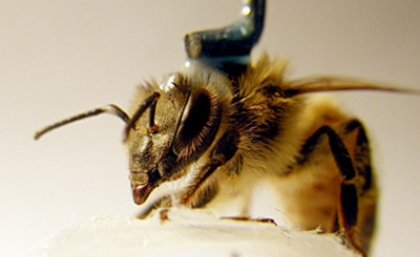
University of Queensland (UQ) scientists are harnessing honeybee flight secrets to develop insect-sized robot aircraft.
A world-first study at UQ’s Queensland Brain Institute has found that honeybees use a combination of what they feel and see to streamline their bodies and gain maximum ‘fuel efficiency’ by positioning their bodies for swift flight.
QBI’s Professor Mandyam Srinivasan said the discovery could help in the development of robot aircraft, such as small insect-like flying machines.
“These bees are living proof that it’s possible to engineer airborne vehicles that are agile, navigationally competent, weigh less than 100 milligrams, and can fly around the world using the energy given by an ounce of honey,” Professor Srinivasan said.
“Honeybees often have to travel very long distances with only a small amount of nectar, so they have to be as fuel-efficient as possible,” he said.
“They achieve this by raising their abdomen to reduce drag so they can fly at high speeds while using less energy.”
QBI’s Mr Gavin Taylor said previous research had found that honeybees used their eyes to sense the airspeed and move their abdomens accordingly.
“When we trick a honeybee into thinking that it’s flying forward by running background images past its eyes, the bee will move its body into a flying position despite being tethered.
“The faster we move the images, the higher it lifts its abdomen to prepare for rapid flight,” Mr Taylor said.
“However, if we blow wind directly at it without running any images, the bee raises its abdomen for only a little while.
“This means that they rely on their vision to regulate their flights.”
The team created a headwind and ran background images simultaneously, and found the bee raised its abdomen much higher than when the fan was switched off, indicating the streamlining response was also driven by airflow.
Professor Srinivasan said the honeybee sensed airflow with its antenna.
“As soon as we immobilised the bee’s antenna, its streamlining response was reduced as it relied only on its eyes.”
Professor Srinivasan said the research could help develop tiny ‘robotbee’ aircraft.
”A better understanding of how these honeybees fly takes us one step further towards perfecting these flying machines,” he said.
Results of the study, “Vision and airflow combine to streamline flying honeybees”, by Gavin J. Taylor, Tien Luu, David Ball and Mandyam V. Srinivasan, have been published in Scientific Reports.
Media: The University of Queensland's Queensland Brain Institute Advancement and Communications Manager Mikaeli Costello:61(0)401 580 685 or Mikaeli.Costello@uq.edu.au
.jpg)


